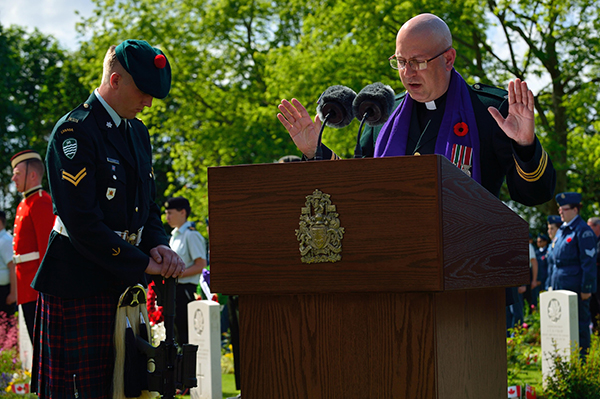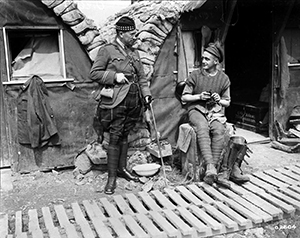Chaplains’ counsel critical to the Army chain of command

Chaplains in the Canadian Army serve in an advisory capacity on tactical, operational and strategic issues to leadership, from the Army unit level through to the echelons of the Canadian Armed Forces.
NOTE: The following article comes courtesy of the Canadian Armed Forces. Lutheran Church–Canada (LCC) clergy play an important role in our military’s chaplaincy, both in regular and reserve forces. In late 2014, LCC helped sponsor an exhibit in Toronto commemorating the role chaplains play in Canada’s military.
by Gerry Weaver
OTTAWA – If asked, many people could probably name two of the three primary roles Canadian Army (CA) chaplains play in the military: offering pastoral care and religious services to men and women in uniform and their families, as well as to other members of the Department of National Defence team. What may not be as well-known is that chaplains are also key advisors to the chain of command and are a critical part of a command team.
Chaplains are found at the tactical, operational and strategic levels within the Army. “We are responsible for the well-being of our soldiers and their families, advising the chain of command and providing religious services. My role at the strategic level also includes providing the chaplains serving in the Army with priorities, fostering their well-being and ensuring that the priorities of the Chaplain General and the CA Commander are reflected in our ministry,” said Canadian Army Command Chaplain Lieutenant-Colonel Leslie Dawson, who holds the senior chaplaincy position in the Army.
Unit chaplains are integrated into their units when they go on exercises and deployments. Because they are present wherever the troops are, chaplains are able to quickly flag potential morale or ethical issues, and when appropriate, to advocate for the troops to their commander.
“Often commanders have a command team consisting of their regimental sergeant-major, the medical doctor and the chaplain. That’s usually the group that can talk frankly about some of the morale issues and the well-being of the unit,” said the command chaplain.
Other types of advice chaplains give to leadership include recommendations on religious, spiritual and moral matters. Compassionate recommendations, requests for religious accommodations, and readiness of individual members for deployment are a part of the chaplain advisory role. As the religious advisors to command, during deployments chaplains can provide advice regarding the religious landscape within the area of operations. “We are religious leaders who are able to enter into dialogue and build trust with the moderate religious leaders in the countries where we are deployed. This capacity is called Religious Leader Engagement,” said LCol Dawson.
The Army has close to 100 Regular Force and 100 Reserve chaplains. The chaplaincy is one of the “purple trades”– meaning its members can transfer among the Royal Canadian Navy, the Canadian Army, and the Royal Canadian Air Force. “Each element has its own command chaplain. The three command chaplains then report to our Director of Chaplain Operations at the Chaplain General’s office to coordinate our efforts,” LCol Dawson said. The Chaplain General advises the Chief of the Defence Staff.
 Those efforts include developing programs and materials to build resiliency, currently the focus of the chaplaincy’s divisional collective training. Resilience in the Army refers to the capacity of a soldier to recover quickly, resist, and even thrive in the face of direct or indirect traumatic events and adverse situations in garrison, training and operational environments. “We are one of the stakeholders at the planning group which is now underway around resilience,” she noted.
Those efforts include developing programs and materials to build resiliency, currently the focus of the chaplaincy’s divisional collective training. Resilience in the Army refers to the capacity of a soldier to recover quickly, resist, and even thrive in the face of direct or indirect traumatic events and adverse situations in garrison, training and operational environments. “We are one of the stakeholders at the planning group which is now underway around resilience,” she noted.
Army leadership at all levels appreciates the significance of the chaplaincy’s influence on spiritual resilience. “Our multi-faith chaplaincy is a powerful advocate for our troops, both at home and abroad, contributing to the Army’s operational effectiveness through our chaplains’ support of the spiritual well-being of our men and women in uniform and their families,” said Lieutenant-General Marquis Hainse, Commander Canadian Army.
Although only the Army chaplaincy received a Royal designation in 1948 from His Majesty King George VI, the Canadian Armed Forces chaplaincy as a whole just received that designation from Her Majesty Queen Elizabeth II in October, 2014, resulting in a name and patch change. The corps is now known as the Royal Canadian Chaplain Service (RCChS).
“I think what the name change does is re-connect us to and confirm the rich heritage of our chaplaincy,” LCol Dawson said. “Today we are the only joint, multi-faith chaplaincy in the world. As we move forward, the Chaplain Service will continue to provide support to all members and their families regardless of their religious or spiritual beliefs, and this includes extending support to those who don’t hold any religious belief.”
———————
This is one of a series of occasional articles on the roles that various special advisors play in supporting Canadian Army leadership. By Gerry Weaver, Army Public Affairs, with files from Helen Bobat.





